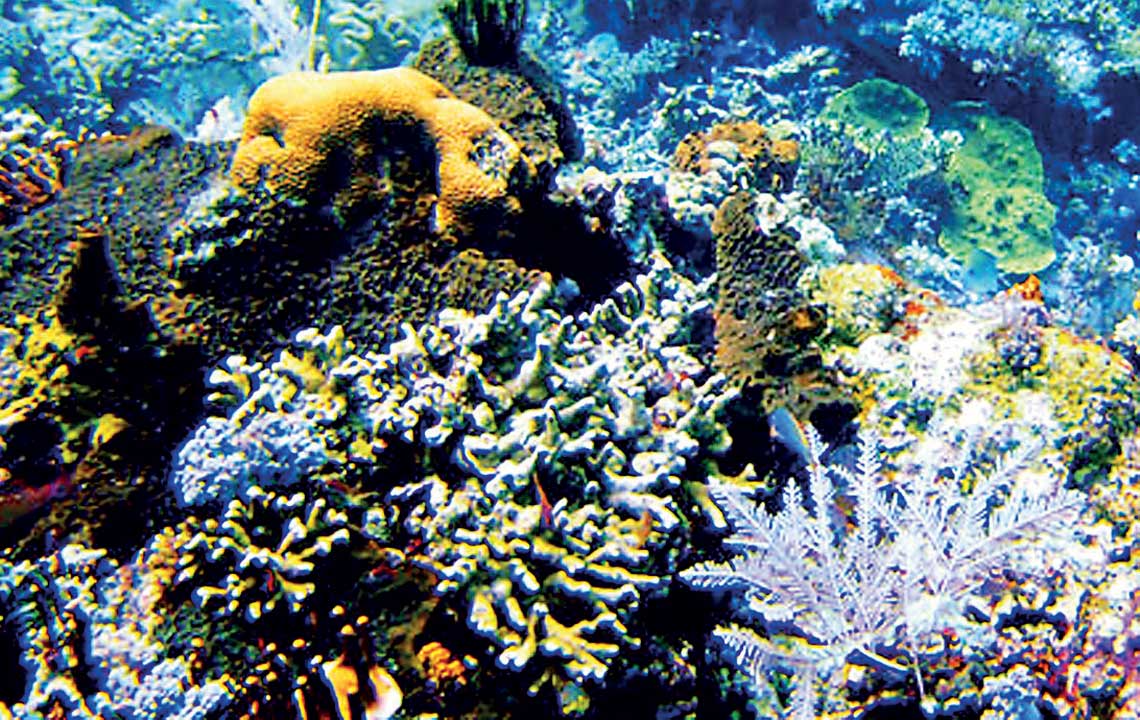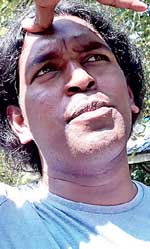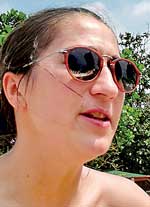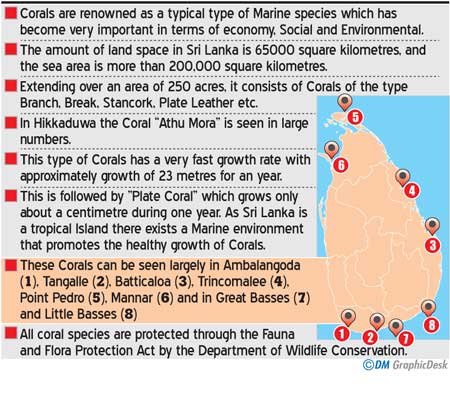23 Jan 2018 - {{hitsCtrl.values.hits}}
 The sky overhead is so blue that it has tinged the ocean below. The scorching sunlight is unbearable. Tourists are all over the place. They are enchanted by the sight of corals. The office of the wild life conservation department located nearby is on guard. Someone emerges from nowhere carrying some bulky items. He is a little away from the rough waves. Some tourists are seen around the person carrying the heavy burden, which contains nothing, but bread. Now we are about to witness a common scene. A myriad of fish of all colours, shapes and sizes throng around him sensing the food they are about to receive. The ornamental fish have got used to this daily ritual and the tourists are thrilled by the large variety of fish and lose no time in clicking their cameras or taking selfies. We encountered the man and our inquiries revealed that he was very knowledgeable about the area, the behaviour of tourists and the impact on our culture and lifestyles of the local residents.
The sky overhead is so blue that it has tinged the ocean below. The scorching sunlight is unbearable. Tourists are all over the place. They are enchanted by the sight of corals. The office of the wild life conservation department located nearby is on guard. Someone emerges from nowhere carrying some bulky items. He is a little away from the rough waves. Some tourists are seen around the person carrying the heavy burden, which contains nothing, but bread. Now we are about to witness a common scene. A myriad of fish of all colours, shapes and sizes throng around him sensing the food they are about to receive. The ornamental fish have got used to this daily ritual and the tourists are thrilled by the large variety of fish and lose no time in clicking their cameras or taking selfies. We encountered the man and our inquiries revealed that he was very knowledgeable about the area, the behaviour of tourists and the impact on our culture and lifestyles of the local residents.


Sri Lanka is a tropical island where there exists a Marine environment that promotes the healthy growth of coral. These coral can be seen largely in Ambalangoda, Tangalle, Batticaloa, Trincomalee, Point Pedro, Mannar and in Great Basses and Little Basses
Dr. Ravindra Kariyawasam
Knowing that we were not exactly tourists, he described his actions in feeding the fish with bread, going on to say that fish love it. He works in a so called hut where snorkeling equipment, to view the corals, and other equipment, to watch the movement of fish, are rented out. Tourists visiting Hikkaduwa from all over the world could purchase eye guards, face covers, life jackets and other safety equipment, and waterproof pouches to carry Mobile Phones during deep sea expeditions from this hut which is one of many doing this kind of business here. Voices calling ‘Hello Sir, Hello Madam’ could be heard from everywhere. The trader throws bread to the fish in order to attract more tourists to his hut. He little realizes that the danger he is causing to these fish that live around the corals. The breadcrumbs do not damage the corals, but the tourists standing on these corals to view the bread loving fish, swim around the trader in large numbers, pose a threat. The tourists unknowingly trample on the corals by walking over them in trying to catch a glimpse of the moving fish. This causes severe damage to the beautiful corals.
Strict regulations
Hikkaduwa Marine National Park, with an extent of 102 hectares, is the first ever National Marine Park in the island. It became a National Marine Park on 18th of May with the release of the Marine species known as ‘Buhu Bawa’ or the creator of corals which was done under the care of the Department of Wildlife Conservation. Close to the beach and in the shallow sea one can see a large number of fringing reef. But human activities like sea bathing, and the movement of glass bottom boats, used to view the corals, continue the damage done to the coral reef. In 1988 it was named as a natural conservation with the view of developing it. All this happened under the supervision of the Wild Life Conservation Department. But however, with the presence of the El-Nino phenomena in 1998, most of the coral lost colour showing signs of decay and death. This was the worst calamity to affect the coral reef in Hikkaduwa. Then it was named as Hikkaduwa Maritime National Park and strict regulations were imposed. With the Tsunami in 2004 further damage was caused to these Coral. The Tsunami waves that came from the ocean brought with them mud, sand and earth which fell on the corals causing further harm to them. Serious damage was caused to the Buonavista coral reef in Roomassala, Galle. Attempts made by environmentalists to mitigate the damage and replant of coral proved futile.

If it is a State policy to develop tourism as an industry, the authorities should be mindful of the increase in tourist arrivals. These tourists, who visit the Marine National Park, should be provided with instructions regarding the behaviour expected from them during their stay inside the park. During snorkeling, and when viewing the coral, the precautionary steps to be adhered to and what not to do should be made known to them. The glass bottom boats, which approach the corals at a very close range, could damage the corals by accidentally hitting them or scraping against them, during manoeuvring. The smoke released from the boats along with the burning of fuel is very harmful to coral as well as to the fish that live among these coral. The hurricane that blew across the Eastern Coast of Sri Lanka in 1978 and the El-Nino which was observed in 1998 were the natural disasters that led to the destruction of the coral. The Buhu Bawas, that live on coral, being devoured by Star Fish also falls into the category of natural disasters. These happenings cannot be controlled by humans, but critics query as what makes the authorities hesitate in taking meaningful steps that are humanly possible? Most parts of Europe are experiencing winter and it is during this time of the year that a large number of tourists arrive in Sri Lanka. One of their favourite destinations is Hikkaduwa. The presence of tourists is prominent in Hikkaduwa on week days whereas the locals converge in on this coastal town mostly during weekends. With the influx of visitors to the site the number of boat rides too increases. On some days the boat rides go up 100 fold. The growth of coral is limited to about an inch a year. But the damage done to the coral through human activity can’t be measured by inches. This damage is caused mainly due to ignorance.
Tourists unaware
Our inquiries from some of the tourists about their opinion on the Hikkaduwa National Marine Park proved futile. This is because they seem to be unaware of what was going on. They were even unaware that they are on a visit to a national park. This is true as there is no one to direct them or guide them. There was no presence of a responsible person representing any State institution. The wild life conservation office located nearby functions in a lackluster manner. The office, which seems apparently vacant, does not extend a friendly gesture to the tourist or for that matter to local visitors. At the time of our visit the officer manning the counter was engaged intensely with a guide perusing the preview of a sporting event published in a periodical that day. This sight reveals what is happening to the tourism industry.
We spotted rows of female tourists sun bathing along the sandy beach. The smile extended to us by one of them urged us to start a conversation with one of them. She was much agitated and said,” I am from Germany. This is my first visit to Sri Lanka. It was only yesterday that we came to Hikkaduwa.We saw lots of Turtles. We did not know that this place was a national park. The visitors at the place cautioned us about walking on coral. We did not know about the forest conservation office. Whatever is said there should be more stringent regulations in order to protect coral. They should at least put up some billboards displaying instructions to tourists. They can also include such guidelines in the website of the wild life conservation department”.
The German tourist who spoke to us is Annisams. She said that her comments and suggestions should not be put aside. It is time the bureaucracy ends and the authorities take steps to meet the needs of tourists and protect natural resources, which Sri Lanka can boast of. Just having an office will not serve the purpose. Maintaining this office will turn out to be another White Elephant.
Hikkaduwa was very popular among tourists many years ago. This was because of the presence of the wonders of nature in the shallow waters in the form of coral. These coral were present in different shapes and colours. With the availability of new technology tourists are more aware of the sights in Hikkaduwa compared to locals. Most of them prefer to bathe in the blue waters of Hikkaduwa. The welcome waves and the blue waters are the only features left to market. They are aware of the dwindling coral. Wild Life Conservation is not updated with regard to the areas where corals can be found.
Amila Tharanga, who owns a tourist hotel in the area,

Amila Tharanga who owns a tourist hotel in the area, is a graduate from the Colombo University and holds a Masters Degree in Geographic Science. His final year thesis had been on coral and accordingly he possesses a vast knowledge of coral reefs
is a graduate from the Colombo University and holds a Masters Degree in Geographic Science. His final year thesis had been on coral and accordingly he possesses a vast knowledge of coral reefs. However from the opinions expressed by those engaged in tourism and activities related to foreign tourists it is clear that Hikkaduwa National Marine Park is just limited to a name board.
Leaving Hikkaduwa our next site of exploration is Roomassala in Galle. This site has added to the magnificent scenery of the coast of Galle and is a few kilometres away Hikkaduwa.
Buona-Vista Coral Reef
Our attention is drawn to the Buona-Vista Coral Reef in Roomassala. Its present situation is much worse than Hikkaduwa. At the time of our visit we observe some tourists carrying away large pieces of coral removed from the site. Like in Hikkaduwa the Buona Vista site is also freely accessible and anyone can engage in vandalism. If the dead coral are allowed to remain in the sea after some time they would again start growing. But due to the human activities that are now predominant in the area the regrowing of coral is doubtful. The boats, used for commercial purposes, converge in the area. Their anchors are thrown into the water and damage the coral. When the anchors are removed no care is taken to spare or safeguard the coral.

Whatever is said there should be more stringent regulations in order to protect coral. They should at least put up some billboards displaying instructions to tourists. They can also include such guidelines in the website of the Wildlife Conservation Department
Annisams

 The Jungle Beach located at the foot of Roomassala Hill is now very popular. It was once hidden from the sight of humans. It had been a prominent sea front with a luscious growth of vegetation and a palm fringed beach. It is now open to the entire world thanks to modern technology. At present it attracts thousands of tourists. The crystal clear beach with its glistening sandy soil was the main attraction for everyone who loved to stroll along the beach on a sunny day. Now it has become an eyesore with heaps of garbage being dumped. Empty biscuit cartons and beer cans are strewn all over. No one has been concerned to clear this garbage. It is a pity that the hotel owners and vendors are turning a blind eye on what is happening. They have striven hard and risked their lives to demarcate their areas of operation on the beach to cater to the vast number of visitors, but paid scant regard to the garbage that is building up.
The Jungle Beach located at the foot of Roomassala Hill is now very popular. It was once hidden from the sight of humans. It had been a prominent sea front with a luscious growth of vegetation and a palm fringed beach. It is now open to the entire world thanks to modern technology. At present it attracts thousands of tourists. The crystal clear beach with its glistening sandy soil was the main attraction for everyone who loved to stroll along the beach on a sunny day. Now it has become an eyesore with heaps of garbage being dumped. Empty biscuit cartons and beer cans are strewn all over. No one has been concerned to clear this garbage. It is a pity that the hotel owners and vendors are turning a blind eye on what is happening. They have striven hard and risked their lives to demarcate their areas of operation on the beach to cater to the vast number of visitors, but paid scant regard to the garbage that is building up.
Coral are known as a typical type of marine species which bears importance in terms of economy, social and environment. It is created by Aquatic Marine species. Over the years it has contributed to our foreign earnings by attracting foreign tourists. It has beautified the environment and there exists many avenues for its growth and development. These corals were broken on large scale and used for purposes of building construction. History associated with cement shows that the Dutch Fort in Galle had been constructed in the sixteenth century using coral. With the awakening of the need for environmental protection and awareness being spread regarding the value of preserving marine resources, identified as Bio Diversity, proactive action is needed to protect coral. The amount of land in Sri Lanka is 65,000 square kilometres and the sea area is more than 200,000 square kilometres. Much interest is not shown regarding Bio Diversity as much of the area is sea. There is also concern when environmentalists do not express much concern. This has led to the increase of misusing Marine zones. The damage caused to the Marine resources is amply visible in Hikkaduwa. According to the latest records coral are facing extinction, unless conservation activities are carried out to arrest this situation. The entire blame now rests with the Wildlife Conservation Department which has been unable to do damage control. What has happened to the Buona-Vista Coral in Galle can happen to the coral in Hikkaduwa.
Dr. Ravindra Kariyawasam, an expert on coral, when posed this question of the wanton damage that is being caused to corals opines, “Hikkaduwa which remained as a Fisheries Security Zone was named as a sanctuary due to the existence of coral and Marine life on a large scale. Extending over an area of 250 acres, it consists of coral of the types Branch, Break, Stancork, Plate Leather etc. In Hikkaduwa the coral ‘Athu Mora’ is seen in large numbers. This type of coral grows at a fast rate.
Such coral grows approximately 23 metres a year. This is followed by ‘Plate Coral’ which grows only about a centimetre during a year. As Sri Lanka is a tropical island there exists a Marine environment that promotes the healthy growth of coral. These coral can be seen largely in Ambalangoda, Tangalle, Batticaloa, Trincomalee, Point Pedro, Mannar and in Great Basses and Little Basses.
Log in to lankadeepa.lk for the video story
Courtesy daily LankaDeepa
23 Dec 2024 2 hours ago
23 Dec 2024 3 hours ago
23 Dec 2024 3 hours ago
23 Dec 2024 4 hours ago
23 Dec 2024 5 hours ago